Sofie B. Ringstad: Tell me where you’re talking from today.
Peter Morin: I’m in a nation called Wet’suwet’en. So, Wet’suwet’en territory, specifically Gitemdan territory, also known as Smithers, B.C. And I have history here. Our family was raised up here. I was here until the age of sixteen, I think. It’s the kind of place where you say, like, “I’m ready to get out of this shitty little racist town!”, you know? I probably shouldn’t have said that, because my siblings just helped my parents to move here and I’ve been here for the last five years probably three to six months of the year.
SBR: You’re giving your life to this place!
PM: Yeah, it’s crazy, pretty crazy… and then there’s all these other secret, magical things. The first time I ever bought beads was from Mountain Eagle Books, and I still have one package of them. Those beads are over thirty years old! And it’s still there. I still shop at Mountain Eagle Books.
SBR: It survived the pandemic!
PM: Yes!
SBR: I know you spend a lot of time there caring for your mother, who… May I ask, what’s the right word to use? To suffer from Alzheimer’s sounds so negative, do you say that one has it, lives with it? What is the correct terminology?
PM: This is such an important question. I had an exhibition here in Smithers with my mom and I’s work. I was just saying the word Alzheimer so damn much that I was like… You know, you get trained to not center white men, right?! You know? [laughs] Why am I saying his name all the time, what is going on? And all the language, all of the language, is so loaded. I know Foucault does a really good job in that one book talking about medicalization – the one where he talks about the history of insane asylums.* The use of the word suffering, the use of the word disease… Every time I write Alzheimer’s the autocorrect changes it to a capital A, after that man, right? But the first person to be diagnosed with it more than a hundred years ago… she has a name, right? So, what I say is – and I’ve come to this through all my thinking – my mother is travelling with a passenger named Alzheimer’s. You know, she’s dying every day. All of us are.
*Paul-Michel Foucault: Madness and Civilization: A History of Insanity in the Age of Reason (1961).
SBR: We just choose not to believe it, I guess.
PM: Yeah. So, the English language – I’m only fairly familiar with English words – they always put a kind of strange distance. So, one of the family philosophies we came up with was: We all have Alzheimer’s. In some regards this is true, because we have a gene – familial Alzheimer’s. Depending on which doctor you talk to, fifty percent of my sibling group are going to get Alzheimer’s. And if you look at the pattern from mom’s sibling group, about fifty percent got it. If you look at her mom, grandma Dinah, most of her sibling group had Alzheimer’s. And I don’t know about our great grandmother.
SBR: I didn’t know it was so inheritable! So you’re spreading awareness. Also through the way you post about this through various social media channels.
PM: It’s a part of the work, yes. When I realized too how hard this is, it became a part of the reason as well… just trying to be really thoughtful, trying to use posting on social media as a way to open up a space for folks, you know, to share. And I’ve had many people reach out to me to talk about their own families’ experiences with Alzheimer’s. Dementia happens, hey? It happens. Alzheimer’s is kind of a lottery of dementia. It’s a special kind of aging of the brain. I try to use the English words better every day. We talk about “when we walked with our mom into the care home”, which means we’re still walking with her, right? Our family members survive about ten years with Alzheimer’s, so she’s kind of on the threshold of her next chapter.
I was talking with my sister from another mother, a cousin from the community, and I was saying to her, “I’m just so done with this word Alzheimer’s”. I’m going to share with you what she, Carrie, replied to me: When grandma Agnes Quock was talking to me about her sister Agnes Tashoots and her journey with A, she told me: “They still have a heart”. Translated in our own language it would be: “K’ā’a medzē’ iht’inh”. So I’ve be trying to say that more. She still has a heart. In my posts as well, I’m adding the hashtag #heartknowledge before #alzheimersawareness.
SBR: I saw you posting about the body remembering. So much knowledge is stored in other parts of our bodies than our brains, right? It’s such a hierarchy.
PM: Yeah, exactly. It makes me like, why? Why are we so obsessed with this one brain? It’s actually two brains, right? Two brains that prioritize communication so much that they make neurolinguistic pathways to each other. The heart is a brain! There are more nerve endings surrounding your stomach than there are going into your brain stem! The stomach is a brain. The skin is accessing and storing knowledge. The skin is a brain. The fat underneath you skin is a brain, you know? And then you say the word Alzheimer’s and people go “they can’t remember anymore”.
SBR: Let’s talk more about your posts on social media. I see this as a conscious action on your end and I’m reading your posts almost as an act of sovereignty – like you’re giving an active space to the memory of your mother, but also to this period of your life. Do you think of it this way? Is it a sovereign manifestation?
PM: I do, yes. I do. Everything takes a long time to make, which is fine. At the beginning of this, she and I worked together on those posts. I would show her what I wrote and we would talk about it as much as we could. And I asked her, “do you want to share this, do you want to share what this is about? They might help other people who are experiencing this”. And she agreed. Now, too, I just shifted a little bit because, whereas before at the front end it was her and I, and then me reflecting on what I was experiencing with her and what we were experiencing together, now we go to her room every night and work together as a team. I’ve started calling us the Night Shift All Stars, ha! Like, the joy of my life right now is pulling the covers up for her, giving her a kiss on the forehead and saying, “have a good sleep, mom”.

SBR: I was thinking a lot about Cultural Graffiti that you did in London in 2013.* To the extent that I know your practice as an artist, I feel like so much of it has to do with care and intimate transmitting of knowledge. For example, when you visited Pocahontas’ gravesite, for me who is researching mothering, it’s almost like you’re mothering the mother, you know? You’re giving back to this kind of maternal figure. Also now that you’re talking about pulling the covers up for your mother, it’s like you’ve entered this reversed role. There’s a definition of motherhood or mothering that I like, it’s from a book called Revolutionary Mothering, which goes like this: ‘Mothering, radically defined, is the glad gifting of one’s talent, ideas, intellect and creativity to the universe, without recompense’.** The giving without not wanting anything in return, you know?
*Cultural Graffiti was a series of performance interventions around London in June and July 2013, where Peter Morin visited and sang to British landmarks.
**Gumbs, A.P., Martens, C., Williams, M. (red.), 2016, Revolutionary Mothering: Love on the Front Lines, PM Press, Oakland.
PM: Beautiful. Yeah, I love that. There’s something about what my mother has offered to me, which I don’t think I could ever… not that I think she wants me to pay her back, you know what I mean, but I just want to do a good job. When I went to Pocahontas’ grave in Gravesend, Kent I just knew exactly what to do, because I’d seen my mother do it. I cleaned her grave the way I watched my mom clean our family’s graves.
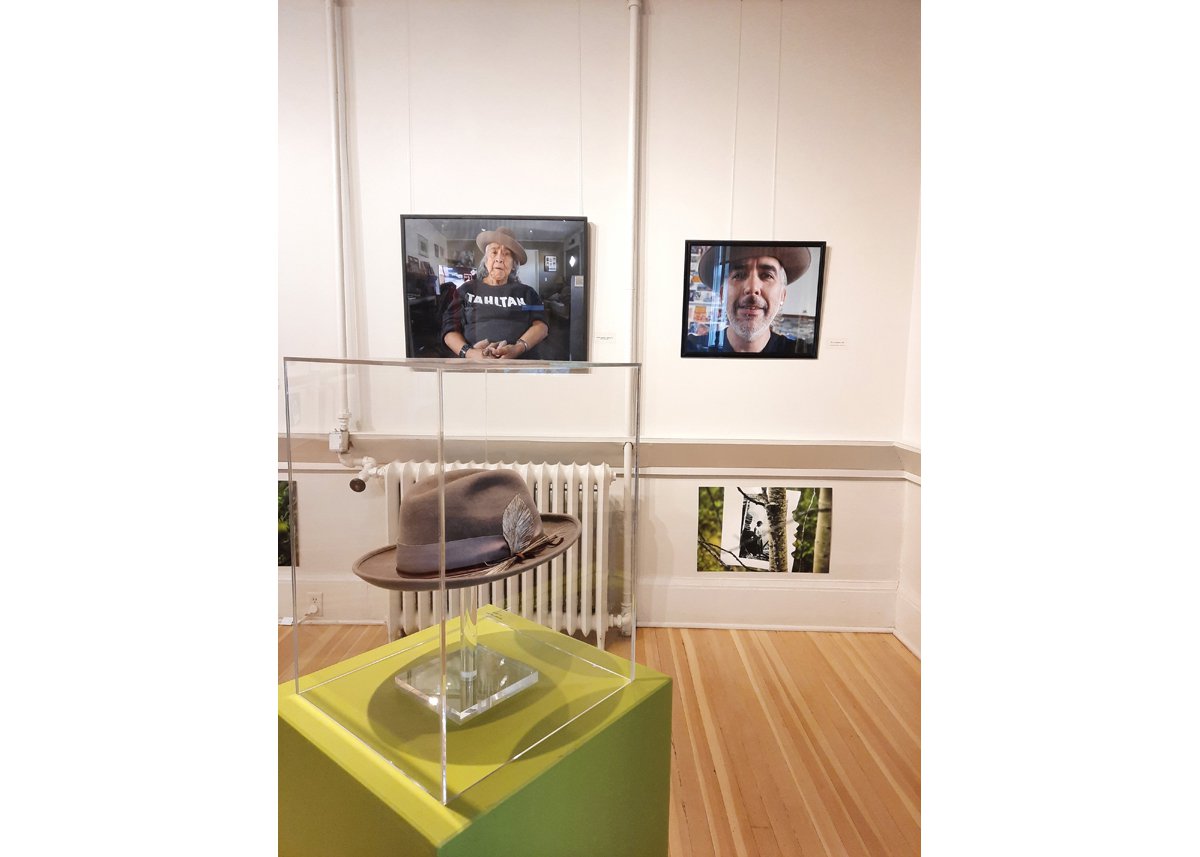
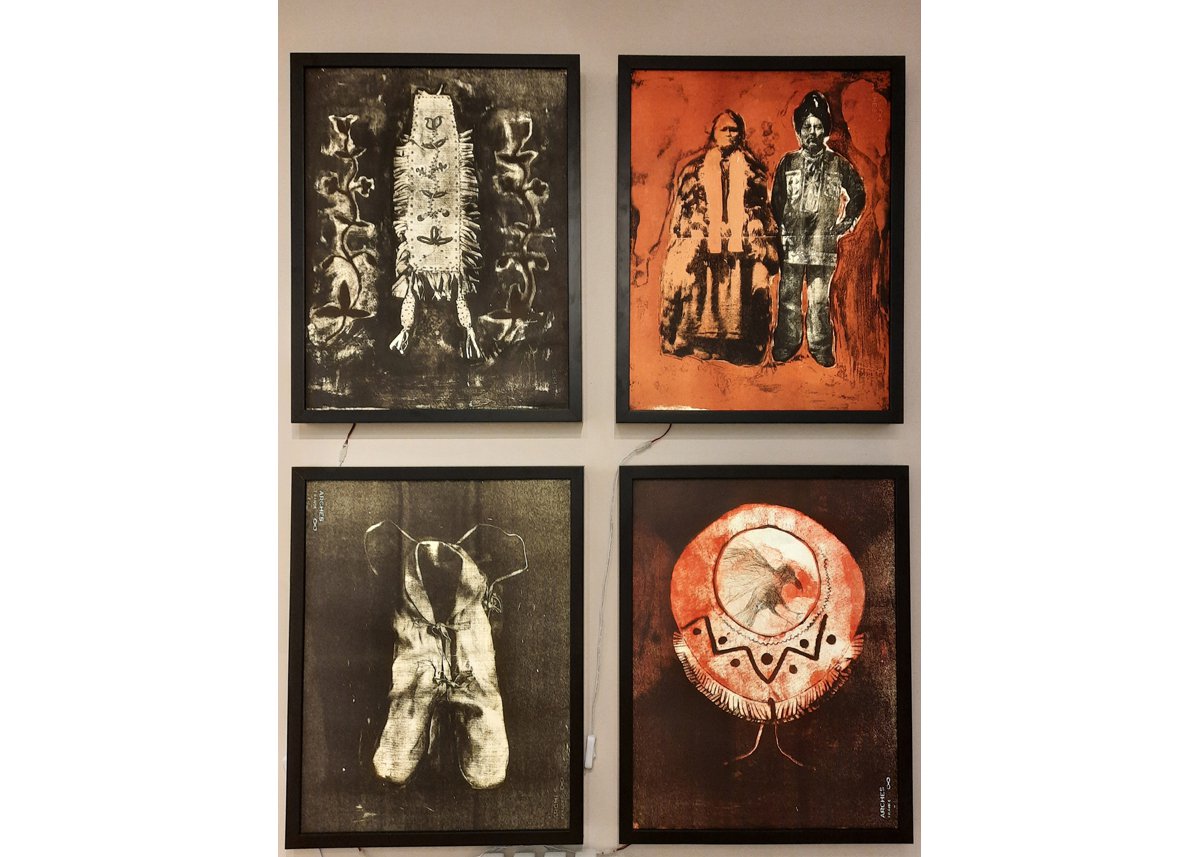
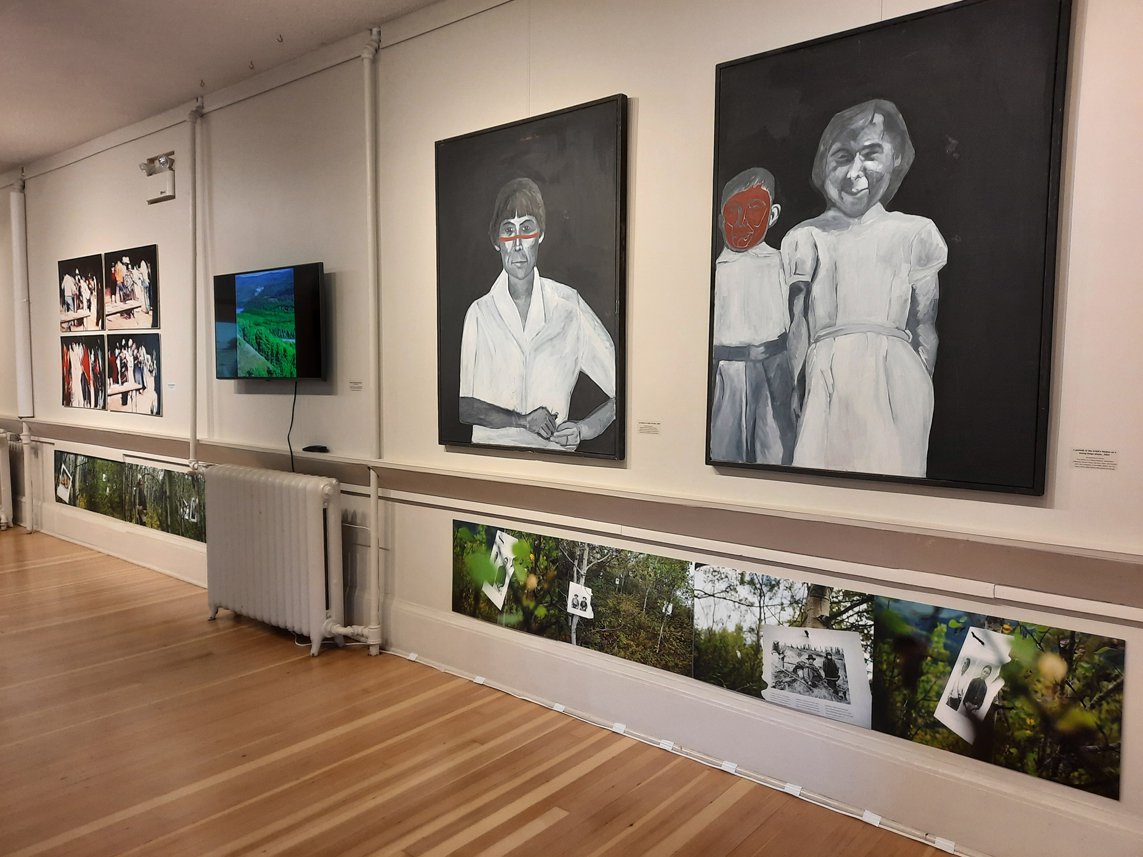
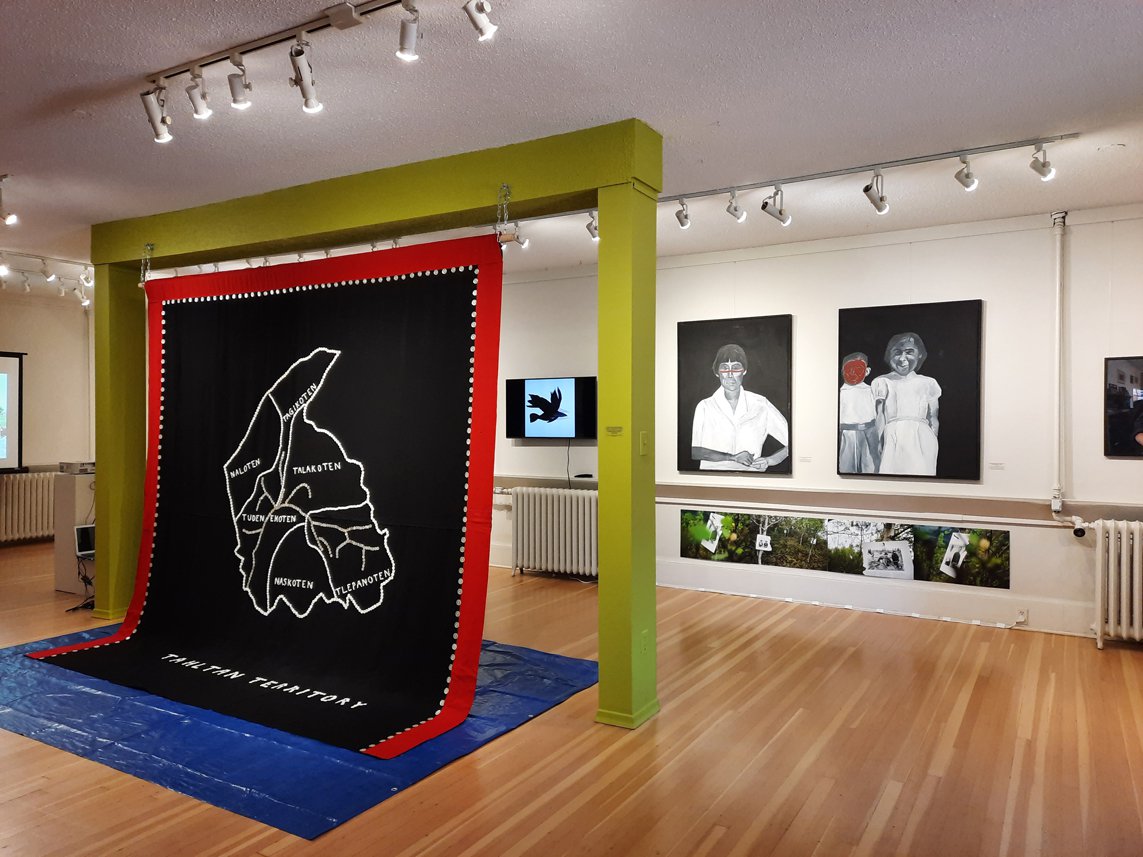
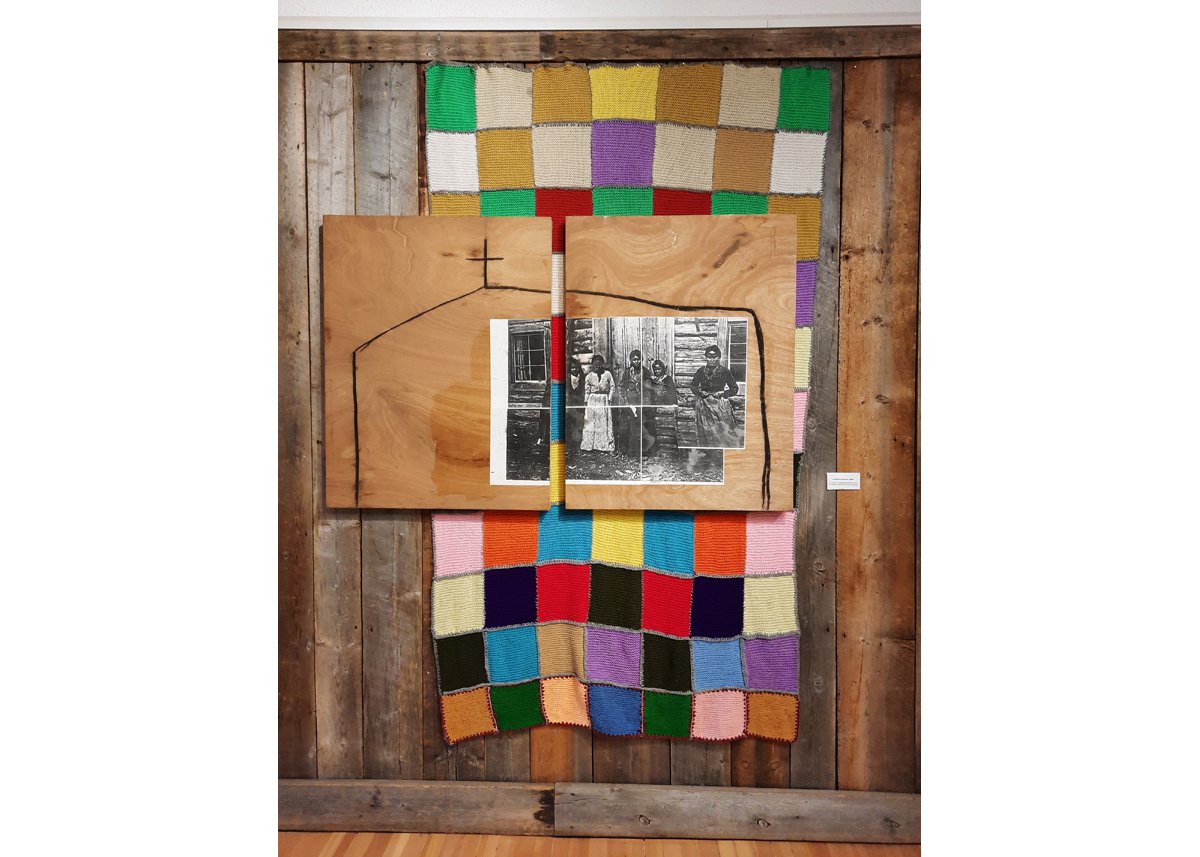
SBR: Tell me about the exhibition you did at Smithers Art Gallery – Didene K’eh Onye Edzūdzah (Her Name is Edzūdzah). I’m curious how this took form as a collaborative exhibition between you and your mother.
PM: There was lots of storytelling connected to everything. I was seeing the artworks as evidence of knowledge transmission and her skill informing and helping to shape my creative choices. The exhibition included over twenty-two years of works, starting from 1999. And also, three new pieces. One of them is a collaboration with stop motion animator named Isaac King*, where I was thinking about what was going on in our mom’s brain. I can’t see her or understand her in a deficit in any way, right?
Part of my work history as well is, I that became a time traveler, because our mom is time travelling, and I wanted to be able to support her time travel. There are aspects of this in my graduation piece from Emily Carr University, where I, in 2000, was making work about Indian residential schools. In the front end there are two wood panels, which are separated by an inch or so, and there’s a black line which travels from one panel to the other, which makes a kind of church shape. On the front are images that I found of Tahltan girls and you can see from the face of them that they didn’t want that picture taken. And then Canada had sold this image as a post card in 1919, which is weird, but at the time I was 21 or 22 years old and just so excited to find and image of bodies that look like mine, that look like Tahltan territory.
Anyway, behind the boards is a blanket of knitted squares and the story behind this was that we were looking after our grandmother, my mother’s mother, while my older sister was doing her very first student-teacher-practical in B.C. And my grandmother had a trailer that her husband bought in 1967. We’re cleaning up her trailer and, inside, I find a bag of knitted squares that our grandma had knitted and put in a bag to be made into a blanket. My mom said to her, to her mom, “Peter likes to knit. Give him the squares”.
The reason for that story is, I would never have been brave enough to ask for the squares by myself. And she was supporting my artistic tendencies – my creative action. And those squares sat in the bag for years. It wasn’t until Mary Ło’oks, a woman from the next community over, stayed at our house in Surrey, B.C. to recuperate after having a brain tumor removed. My mom looked after her and her siblings when they were kids and now was looking after her again as an adult. And Mary offered to crochet the squared together. All this – those actions – became part of the work.
*Peter Morin with Isaac King: Feathers are Another Form of Memory, Part 1 (video, 4 min 00 sec., 2022).
SBR: The older you get, the more you realize how great an influence certain people – and especially a mother – have on your life, right?
PM: Exactly. I also wanted to pursue the exhibition because I wanted to show that even with Alzheimer’s you are still making knowledge, you’re still making cultural knowledge, and you are still practicing. And that was important to me because, as well as Western, White culture being very stand-off-ish with this disease, our community is also. So, my mom wrote a song: I made all these pillows with our faces on them, because I thought she’ll wake up and see people that love her and she’ll feel loved. One day, we were sitting there watching Ghostbusters together, and she holds up the pillow by me while I’m sitting by her, and she sings a song: [sings] “Peter, Peter, I miss you already, I wish you were coming come, I wish you were coming home”. And I thought… that’s a beautiful song.
So, part of the exhibition was a way for me to get that song moved into our Tahltan language, and then offer the song to the community. It’s also important to say that this song – I mean, I’m only one Tahltan person of, like, less than five thousand of us – so I think, and in my limited scope of Tahltan world, this is the first new song written by somebody. And she has Alzheimer’s, which means it’s the first song ever in our language written by somebody who has Alzheimer’s. I worked with my cousin, my sister-cousin, and her partner En Galena Ło’oks, to translate the song into Tahltan. [sings] “Edzūdza k’at enaga esdī’ iya’e, Dūli kime tlāndīndā”. We did that here. The performance was called She carried us to the territory. Yeah.
All that stuff there in the exhibition room supports to get people to the right kind of energy to have that performance. And then, also, my mother is in the care home. And I need those folks, the care people there, to love her as much as I love her. And this was kind of a sneaky way to do that. They could see the evidence of her work. I gave five artist talks, community talks, and in every single one of them I said “this is only my part of the story – she has helped numerous people in the same way and if we had the chance, all of us, to reflect on how Edzūdzah has helps us, we would fill up this entire town”. I also did radio interviews, which was really great to because I need them, really need them, to think about this. How do you overcome systemic racism in an institution like a care home? Maybe you can’t. But if you get White, racist folks’ egos involved, like; your ego is more important than racism! You know?
SBR: Oh totally, ego before racism. Let me just take a note of that here…
PM: [laughs] It’s so bad! And so funny, and so… Think about how this makes you proud of your day. Maybe don’t be racist.
People in general. But I had an underlying current of reaching the caretakers – upping her status. I don’t know how, in these service environments… I used to be a front-line service provider. This was something that lots of folks struggled with, too. How do you honor the lived experience of the people you’re working with? There’s so much memory in a care home. So many exceptional lives have been lived. So, I was like, how do I get them to open up to the possibility that our mom has lived an exceptional life and needs to be treated accordingly – to be treated with love?
SBR: So, you did these radio interviews specifically to reach out to her caretakers?
PM: People in general. But I had an underlying current of reaching the caretakers – upping her status. I don’t know how, in these service environments… I used to be a front-line service provider. This was something that lots of folks struggled with, too. How do you honor the lived experience of the people you’re working with? There’s so much memory in a care home. So many exceptional lives have been lived. So, I was like, how do I get them to open up to the possibility that our mom has lived an exceptional life and needs to be treated accordingly – to be treated with love?
SBR: I’m sorry, Peter.
PM: Thank you, my friend. I appreciate that. It really sucks.
SBR: In the Smithers Art Gallery show, the exhibition text starts with a line saying that your most important job is being a son. I guess that’s what it all boils down to.
PM: Yeah, it’s my most important job. That also comes from the pandemic. We lived through this period of time and just the amount of hours that I was at work things – it just filled up. And everybody says: “This is my job, this is what I do at the university”, and so on. Ayumi* and I would be talking every day, because the friendship is the studio. And through those conversations I realized I had to change my introduction of who I am. Also, you know, coming from a place of culture where you’re not really supposed to brag about your yourself… So that’s when I started to say that my most important job, my real job, is being a son, a brother, an uncle, a cousin, a community member.
*Ayumi Goto, Peter’s friend and artistic partner.
SBR: Like a disclaimer. And then, the ego! And after that, the racism. In that order! [laughs] We laugh, but of course it’s not funny at all.
PM: [laughs] But your body has to process it somewhere, somehow.
SBR: We went so many rounds now, Peter. Do you have any closing remarks, beyond ego before racism? I might have asked this already, but we reeled off: How has the whole process, all the aspects we talked about now, changed the way you think about memory and remembering – and mothering, for that matter?
PM: The English words fail me here. I want to say that there’s a fearlessness about how our mom goes through the day. But I don’t know… the work of artists needs to have that fearlessness in order to build something else. To build a different way. I’ve been strengthening this line of thinking about how the artwork is a kind of remembering. Part of the time travel stuff was that the ancestor artists have never not imagined me. So, they are making artwork that speaks a language to me. Part of that relational exchange requires that I also try to make things that remember this current time, but that also needs to speak to those future ancestor artists. The objects and artworks are the real time travelers.
All this stuff comes from working with mom too, and her current lived experience with a passenger called Alzheimer’s. Before it turned into winter here, we’d go on the nice days and take her for walks in her chair, and lately I’ve been thinking about that – how bodies are transforming all the time, so her body is… I feel like Donna Haraway has written about this… my mom’s body now includes these wheels, but I realized too, that I am the one pushing the chair, helping the movement. So my body is inherently her body, connected to these wheels, and our bodies are constantly transforming.
Recently, because I have a lot of time on my hands, I’ve also been returning a lot to the older White anthropologist documentation of our old Tahltan Nation stories. And they’re writing about transformers! Beings and bodies that transform. So, I’m walking with my mom, and we’re moving in this new way, and I realized… we’ve transformed ourselves into a whole new body! So how do I make artwork, an object, that holds on to that memory of her and I? There’s some more things there, too. I learned right away that the colonial situation here on these territories, if you can’t remember, or you have some kind of memory impairment, that also pulls you out of that colonial situation.
SBR: Is it almost a release?
PM: I want to say that it’s kind of a beautiful freedom. But these days I don’t trust the word freedom, in the English word, how it’s used, right? But in this colonial context, I feel like you’re trained to look at the negative first. So immediately I started looking at the people who distrusted mom, because she couldn’t participate in that colonial dialogue. And that, I think, is still kind of potent. Yeah, I think that’s it. Those are my parting remarks.
SBR: It’s good to end with the word potent. It leaves a certain energy.
PM: [laughs] Yes, it does!
* This interview is part of Sofie B. Ringstad’s master’s degree Mothers, Mothering and the Mnemonic (Weißensee Kunsthochschule Berlin, supervised by Dr. Prof Bonaventure Joh Bejeng Ndikung and Prof. Nasan Tur).
Sofie B. Ringstad (b. 1992) is a Stavanger-based curator and writer. Building on her career as a manager in fringe music and art fields, she consults artists and institutions at the intersection of visual and time-based art. Sofie holds a Masters Degree in Spatial Strategies from the Weißensee Kunsthochschule in Berlin, and is currently engaged as a curator for KORO.
Focus: Art and Responsibility is supported by Fritt Ord.


